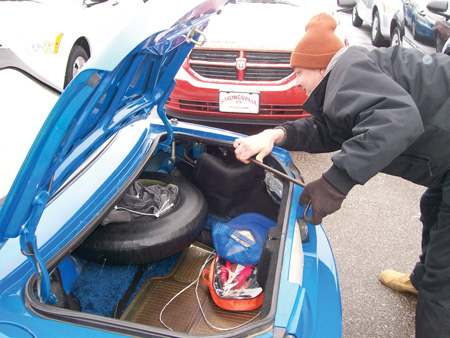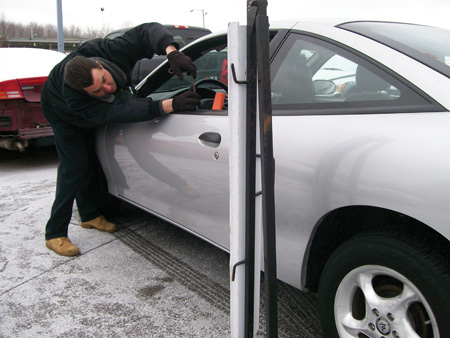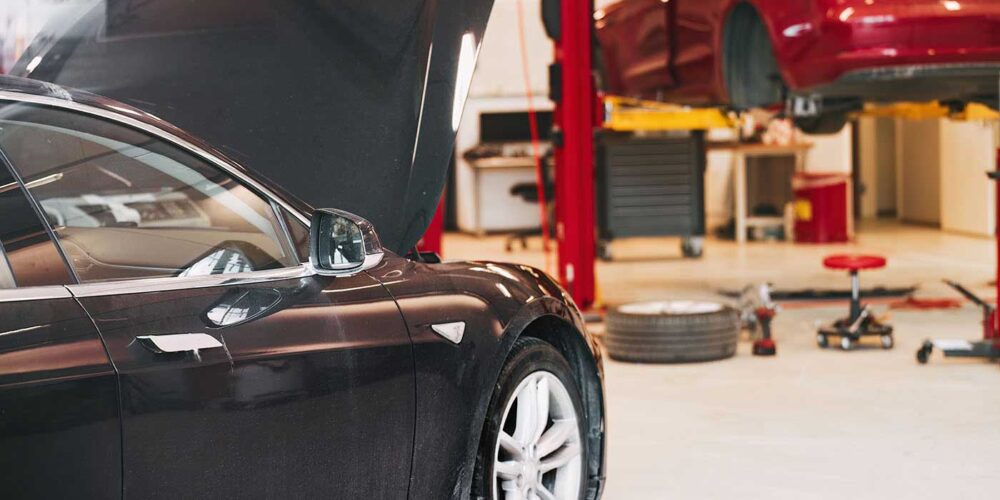
 In a world of specialists, paintless dent removal (PDR) has become a niche market of its own. It requires training and practice and is a bit like becoming a professional golfer or concert pianist: The more you do it, the better you get at it. Lay off practicing for a week or two and the skill suffers.
In a world of specialists, paintless dent removal (PDR) has become a niche market of its own. It requires training and practice and is a bit like becoming a professional golfer or concert pianist: The more you do it, the better you get at it. Lay off practicing for a week or two and the skill suffers.
Worth the Time?
From the body shop manager’s point of view, it might not be worth the time to train a technician. Yet most shop owners appreciate having a PDR specialist on call to handle appropriate jobs. They know it has a place but are reluctant to train an in-house technician who may quit the shop or use the PDR skills only a few hours a week.
“PDR is great but it has to be the perfect scenario,” says Vince Konopka, managing partner at Strongsville Body & Paint in Strongsville, Ohio. He says that the majority of the work that comes into his shop is too substantial for PDR. “I do offer PDR,” he continues. “It appeals to the customer who’s paying for the job and is happy to get 95 percent of the problem fixed for $75 instead of 100 percent for $475.”
a few hours a week.
Even with its co-location with the local Dodge dealer’s used car lot, Strongsville Body cannot justify a full-time PDR tech. Instead, it uses Dean Messner of Dentcare, Inc., in Bainbridge, Ohio, who comes around once a week.
Messner travels a regular route that includes a number of dealerships, the Auto Mile and used car lots. The shops he visits are happy to rely on his 15 years of expertise and speed when it comes to fixing dents. Many other shops feel the same way about relying on PDR experts.
“We sub-out our PDR work,” says Richard Willard, manager at the Service King Collision Center in Plano, Texas. His is one of 21 Service Kings in the area. It’s simply more cost-effective and efficient for them to bring in 10 or 12 PDR specialists when there’s a rush of PDR work – especially during hail season, when cars are spattered with small dents and dings.
“They are specialists. The outside guys do the PDR work while we take care of our regular business,” Willard says.
Warren Schleuter, body technician at Tracy’s Collision in Lincoln, Neb., has worked with PDR. However, he agrees with Willard that the job is better done by those with expertise who practice the skill full-time.
“I’ve played around with it for a while, but I’m a long way from pushing dents for money,” Schleuter says. “I don’t have the time to improve my skills. You’re looking at six to eight months of practice with PDR work before you’d feel comfortable charging for it.”
Even with the time he has been practicing, he only uses his PDR skills for small jobs where there’s a dent in a blend panel. He will push it before they glaze over it.
Like Schleuter, Konopka has his own set of PDR tools. He took a three-day course to learn the basics. “But unless you do PDR all of the time, you’ll cause more damage than you fix,” he says. “If you crack the paint, you’re back to a full repair.”
Commitment Necessary
While the skills of a traveling expert like Messner are available by the hour, a body shop manager has to be willing to commit a lot of resources to maintain an in-house PDR specialist. Not infrequently, the PDR tech will move on, taking the shop’s investment in training and experience with him.
Precision Body & Paint in Beaverton, Ore., used to have a PDR tech. But he left, and now the shop subcontracts its PDR work. “Due to the caliber of cars we work on (Porsche, Audi, BMW and other top-market European vehicles), we don’t have a lot of calls for PDR,” says owner Ron Reichen.
Precision Body & Paint sees 140 cars a week through the shop and perhaps five are legitimate candidates for PDR. That means its PDR man wasn’t doing a lot of PDR. The tech spent most of his time doing regular body repairs. “He was a cross-trained journeyman bodyman,” Reichen says.
Konopka says he feels the best places for PDR are on used car lots where there are a number of small dings to fix or in areas with a lot of hail. “You can’t get every dent out of every area,” he says. “You might get the majority out. It works well on used cars where people are more tolerant of some minor bumps and dings from parking lots.”
Since his shop is on the same lot as a used car operation, Konopka thought it might be able to make some money doing PDR in-house. “[The used car operation] does $300 to $1,000 a week of PDR,” he figured. “I’m here every day – it could be a profitable sideline for us and a convenience for them.” But it didn’t work out that way.
“The flip side to PDR is all the holes you drill in quarter panels and wing panels,” he continues. “Everywhere you drill a hole, you expose the car to the possibility of rust in the future.” Even with a rustproofing plug, the vehicle is still exposed to the possibility of rusting from the underside out.
“PDR is perfect for all the little ‘oh, damns’ you see in a day’s work,” Konopka says. “But it’s not for everything.”
Like Konopka, Reichen says his biggest concern when using PDR is that the process can weaken the vehicle’s corrosion protection. “If you can’t access the dent by removing trim, then you shouldn’t do PDR,” he believes. “You can’t compromise the corrosion protection.”
Reichen has seen cases on used vehicles where the inner structure was cut to fix a ding…hardly a valuable long-term solution.
Tracy’s Collision also keeps a PDR specialist on call throughout the year, and the specialist makes a good living from its shop, other body shops and used car lots.
Even in the slower PDR seasons, Service King will have cases that call for PDR work. That’s when it calls in its PDR company, which will send a subcontractor to the shop within 30 minutes or an hour.
Practiced Eye Key
In a typical scenario, a PDR specialist will come to a body shop that might have a few vehicles with dings that need to be repaired. In addition, individuals from the community will bring vehicles for work. A standard fee might be in the area of $40 to $75 per dent removed. The job is done while the customer waits.
Leigh Sorby, manager of Autohaus Autobody in Chicago, also hires out his PDR. “We are a bit fussier about the job. We aren’t just selling used cars,” he says. He has used both an in-house specialist and a traveling service.
His in-house technician did well with PDR for several years until he had to leave the job for family reasons. “Now, we’ve used the same outside person for 12 years. I can trust him to do it right, to not break the paint or to tell me if the situation is just not right [for PDR],” Sorby says.
A good PDR technician can eyeball a job and know whether it will work. He knows how to get in through a window to fix a door panel or gain access to a rear quarter panel through a taillight housing.
When the situation requires drilling a hole, it’s also key to have a kind of mental x-ray vision so the hole isn’t put on the outside of a body brace or in an otherwise worthless spot.
Messner’s training was fairly informal. “I worked with a buddy in a garage. We’d work on top sheets – put our own dents into hoods and panels and then push them back out,” he recalls.
He later rode with his friend for about six months before going out on his own. “I learned on the spot,” he says. His practiced eye can tell, for example, when a dent will pop well or will result in spidering and a worse problem for the finish than he started with.
Like many other PDR specialists, most of his work is done outside. His years of expertise allow him to see which dents will come out easily when the metal is cold and which are better left for a warm day or to be done inside a shop.
Balancing Act
It can be tough to make the business case for the average body shop to train an in-house PDR specialist. For one thing, Willard notes, the turnover in the industry is so rapid that an owner cannot assume that a well-trained PDR specialist will still be around in a year to repay the cost of training and maintaining his or her PDR skills.
“PDR is like plastic body filler – there’s a place for it, but don’t abuse it or use it as a fix-all,” Reichen says.
“The real concern is if there’s enough work to do – not just a door ding here and a door ding there,” Willard says. The alternative, he says, is a “combo-guy” who does both PDR work and body work. While that worked at Precision when the tech remained an employee, even that solution isn’t always efficient. The expectation with customers is that a dent will be poked out in a few minutes.
“PDR has to be done so quickly that it can hurt the body side of the business,” Willard says. “When a PDR customer comes in, it’s necessary to take the cross-trained tech off of a body job and let him do the PDR repair. That delays the big job.”
Schleuter sees the situation the same way at his shop. He says that he could work a combination man, but it’s better to use an outsider with the expertise. “The people who come in and work with body shops like us know what they’re doing and do it all the time,” he says.
“It’s a win for the company to get the PDR business, but a loss for the customer whose job is put off,” Willard says. “Our business is so service-oriented that you don’t want to push a body shop customer’s service day back to handle a bunch of little jobs. You might gain some PDR work, but the collision customer will be a loss to the company.”
Konopka echoes most shop managers when he says, “You’ve got to do a lot of cars to be good at it. If you get out of practice for one or two weeks, you’re done.” That’s why Strongsville Body, Tracy’s, Service King and many others that like to offer PDR to their customers rely on a specialist to do the job and do it right.
Curt Harler is a Cleveland-based freelance writer specializing in the automotive, technology and environmental areas. He is the recipient of the International Communications Association Industry Achievement award for his writing. You can reach him at [email protected].
|
Insurance Industry Getting Keen to PDR, Says PDR Expert
I’ve been a PDR technician for more than 16 years and have devoted most of the past 10 years to subcontracting for body shops across the country for hail repair, dings and larger dents. I’ve seen the repair capabilities and skill levels of PDR techs greatly improve over the past several years because of better tooling designs (e.g. rubber and nylon tips and corrosion spray coatings addressing corrosion protection concerns), professional advanced instructors and glue-pulling technologies. Veteran skilled technicians can now repair large and complex dents to a consumer-acceptable level that was previously not thought possible. The insurance industry has become keenly aware of the improvements in the level of PDR repairs and the abilities of PDR techs. They realize the potential cost savings and are encouraging and pushing what was once considered conventional repair to the PDR arena. This includes combining conventional and PDR repairs, which is a process known as “push to paint.” PDR tools and methods are used to straighten the damaged area so that a minimal about of pre-paint prep time is needed. Ideally, the metal can be straightened enough so that it can be high-build primed and blocked and readied for paint. Many larger soft dents and creases can also be repaired to a commercially acceptable level through PDR. I believe that more and more conventional repairs will be written for PDR as the industry matures and insurance companies see the increased viability of its capabilities. PDR is only limited by the physics of stretched metal, impossible or difficult access because of the location of damage and technicians’ individual skill levels. There are several different areas that PDR techs can specialize in. Route techs, who service auto dealers, become very familiar with side panel damage. Hail techs become experts at top panel repairs. Several insurance companies don’t allow drilling for PDR access. Competent hail techs have learned how to perform PDR following these guidelines; for example, de-trimming panels for access, using advanced tooling designs and using glue-pulling procedures. Route techs are sometimes not as familiar with no-drill techniques because drilling is largely acceptable at auto dealers and wholesalers. When done correctly, PDR brings a car completely back to pre-loss condition and, in my opinion, wipes out any issues with dimished value. – Tom Price has been involved in all aspects of the PDR industry since his training in 1992. It was while chasing hail storms that he developed a vision for hail repair, hail teams, personalized PDR training, education, industry consulting, business networking and communication forums. He helped conceptualize the Mobile Tech Show and founded the International Dent Olympics competition. He has also written many articles for Mobile Tech News. He was the longtime owner of DentNetwork.com, a clearing house for industry news and information. To date, Tom has trained more than 150 students worldwide. He currently puts his time and energy into pdrcoach.com with his partner Michael Hand. He currently resides in Missouri and can be reached at [email protected]. |













